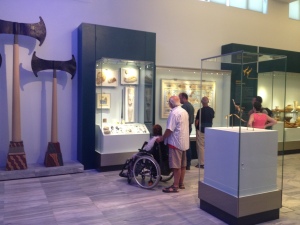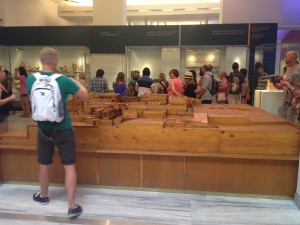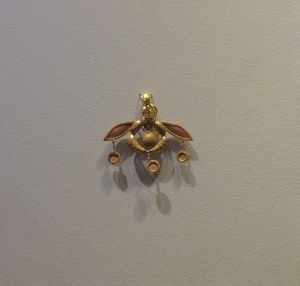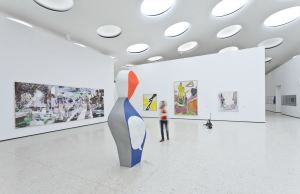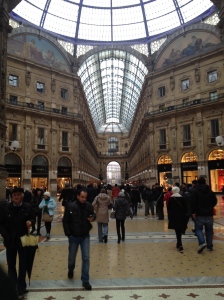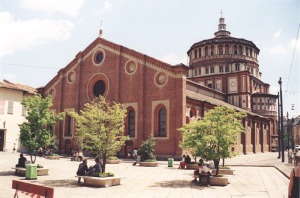: Brittany Wade
The New & Improved Heraklion Archaeological Museum

Heraklion Archaeological Museum located at Xanthoudidou Street 1, Heraklion 712 02
In the Summer of 2012, I made my first trip to Crete. I was so excited to finally see the land of the Minoans, the oldest civilization in Europe and a civilization who’s history inspired me to become an archaeologist and heritage manager. I could hardly wait to see the Phaistos Disk, Kamares ware pottery, the bull shaped rhyton, and the Aghia Triada sarcophagus. To my dismay, the museum had been closed for renovation (for over 5 years at the time!) but the more famous artifacts had been moved to a very small temporary exhibit down the street. While I did get to see my favorite artifacts, the experience was lacking the other 99% of Minoan finds that have been discovered! It was unknown as to when the new and improved museum was going to open, but I was willing to wait…
Now in the Summer of 2014, I am back in Crete again and had the pleasure of seeing the brand new Heraklion Archaeological Museum. After nearly 7 years of rebuilding and renovations, Crete can now claim that the renovated Museum has nothing to envy from the other modern museums of European metropolises. From the Neolithic Age to the Roman times, the collection of the Museum covers 5,500 years of history. It is the greatest collection of art and relics of the Minoan Civilization in the world!
Having only just opened on the 6th of May, the Museum is already attracting an enormous amount of tourism. It exhibits 5,865 artifacts (not including the coin collection) in chronological order spanning nearly 15 rooms across two floors. Even some brand new artifacts that have not even been published yet are on public display! Although those artifacts are not allowed to be photographed, everything else is (sans flash). The famous highlights of the museum are ideally displayed in protective cases with exemplary lighting and informational panels. Originally, only the Bull Leapers and Prince of Lilies frescoes were apart of the temporary exhibition, but now, the even more spectacular artworks from the Palace of Knossos are back on display in the upper floor’s fresco gallery. My favorite fresco, The Blue Ladies, is back home in Crete after many years at the Metropolitan Museum in New York!
The Museum also displays some of their exhibits in innovational and educational ways. For instance, the larnax and burial pithoi are shown with the bones of the deceased still inside them. A giant reconstruction conveying the Palace of Knossos is displayed, not in a glass enclosure, but assembled of wood that fills almost the entirety of the room.
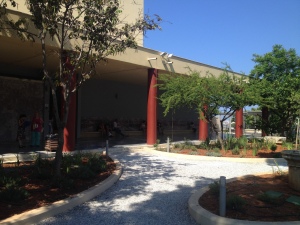 The Museum itself has seen its own heritage in the making over the last three decades. While constructing the Museum’s courtyard, remnants of a fountain, cistern, and pillared building were found destroyed most likely due to cannon fire during the siege of the Ottomans. A skeleton of a man was revealed under the ruins of a door among Venetian coins and bronze rings. Since the site was used as an open fort battery during the siege, many skeletons like this man’s were found in the area and are now forever immortalized as the last defenders of the city from capitulation by the Ottomans. You can’t dig an inch any where in Greece without stumbling upon some fantastic historical heritage!
The Museum itself has seen its own heritage in the making over the last three decades. While constructing the Museum’s courtyard, remnants of a fountain, cistern, and pillared building were found destroyed most likely due to cannon fire during the siege of the Ottomans. A skeleton of a man was revealed under the ruins of a door among Venetian coins and bronze rings. Since the site was used as an open fort battery during the siege, many skeletons like this man’s were found in the area and are now forever immortalized as the last defenders of the city from capitulation by the Ottomans. You can’t dig an inch any where in Greece without stumbling upon some fantastic historical heritage!
The Museum is placed in the heart of the city and is also conveniently located en route from the Palace of Knossos by public transit. Check the Ministry of Culture website for ticket prices and operating hours. According to TripAdvisor, it’s the #3 attraction to see in Heraklion, and that is expected to go up as more and more people make their way to the new facility. Check it out for yourself and I dare you to leave feeling disappointed!
Brittany Wade is the editor of the Initiative for Heritage Conservancy blog and student of the MA in Heritage Management 2013/2014. Having studied Classics in her undergraduate, Brittany is interested in applying her knowledge of history in the field of archaeology and heritage management. Her interests are mainly in Prehistoric Minoan and Hellenic history.
Photography & Cultural Heritage Workshop
At the beginning of the Spring Semester, the students of the MA in Heritage Management were offered an opportunity to participate in an extracurricular workshop in photography of cultural heritage. The workshop’s first lessons introduced how heritage has been conveyed through photography in the past and in modern times; the next series of lectures gave us the basics on how to use our cameras as well as photographic techniques to make our photos look more professional. The course also encompassed a couple of photography days where we went around outside to practice these newfound techniques.
Using Elefsina as a case study, we were divided into four groups, each with a certain focus. Group 1 was to examine Elefsina’s Industrial Heritage, Group 2 was to capture the Architectural Heritage of Lower Elefsina, Group 3 was to look at the Iera Odos (Sacred Way) as a Cultural Monument, and Group 4 was to illustrate the Tourism Marketing potential of Elefsina.
Group 1: Industrial Heritage
The industrial heritage of Elefsina is vast and complicated, with many facets of interest. This group decided to tackle this subject as a communication between Industrial Heritage and the Water Front of Elefsina.
Group 2: Architectural Heritage of Lower Elefsina
The artistic decision for this project was to take photos of buildings on one street from beginning to end, and to observe its mixtures of architectural styles and designs, to help remind audiences of “why those buildings were built in that way” with connection to the history of Elefsina and those locals who lived there.
Group 3: Iera Odos as a Cultural Monument
In a project entitled “The Perennial Sacred Way,” this group decided to explore the Sacred Way that goes from Kerameikos in Athens to Elefsina both as a cultural monument and as a road; the former being static, unchanging, and the latter being dynamic, always moving.
Group 4: Tourism Marketing of Elefsina
The objective of this project was to convey Elefsina outside of its industrial identity, showcasing the city’s longstanding history and vibrant citizens. Subject matter included the archaeological site, shopkeepers, outdoor markets, and Elefsina’s unique seafront. The approach of marketing was tackled by conveying a day trip of the city through a couple’s perspective.
The workshop will be running again next Fall for the 2014 Masters students and will include more archaeological sites in the greater Athens area.
Brittany Wade is the editor of the Initiative for Heritage Conservancy blog and student of the MA in Heritage Management 2013. Having studied Classics in her undergraduate, Brittany is interested in applying her knowledge of history in the field of archaeology. Her interests are mainly in Prehistoric Minoan and Hellenic history.
Gegenwartskunst in Deutschland
Recently I took a trip to the Northern German city of Düsseldorf to visit a friend who is studying painting at the world renowned Kunstakademie. While there, not only was I able to see the student exhibitions at their annual Rundgang, but I was also exposed to a whole new way of experiencing contemporary art (or gegenwartskunst) at several German museums. I was in awe at the artist’s ability to engage the viewers with their vision as well as how a unique museum space can influence a visitor’s experience of a collection in such a powerful way.

The K21 Ständehaus also known as the Kunst Sammlung Nordrhein Westfalen. Photo Credit: Brittany Wade
I went to several museums while in Düsseldorf, but the one that stuck out the most by a landslide was the K2 Ständehaus. In the now growing urban metropolis of the city, the building itself stands out with its traditional architecture and reflective glass roof. The architecture of the outside of the building has a very stark contrast with its interior, which is a vast open space with corridors filled with contemporary art exhibitions. I was surprised after buying my ticket to be handed a waiver that I had to sign acknowledging the physical danger of one of the installations. I had no idea what this would entail. Had I looked up at the ceiling, I would have fully understood. This was the amazing installation by Argentinian artist Tomás Saraceno called In Orbit; a construction of steel nets and half a dozen floating orbs suspended from the glass canopy roof of the museum.

Tomás Saraceno’s in orbit installation at the K21 Ständehaus. Photo Credit: kunstsammlung.de
This was not only an installation to be seen, it was one to be experienced. We were able to put on fitted jumpsuits and boots and enter the piece to move freely between three levels of netting. If more than one person enters the bold design, an oscillating network of relationships, resonances, and synchronous communication would vibrate throughout the structure. Saraceno had studied the intricacy of spiderwebs for decades and created this piece to move with the same elasticity as insects moving on a web. This is a rare art form that directly evokes certain emotions from its visitors, entangling both fear and excitement; evoking floating, flying, and falling all at once. Pillows had been thrown on to the netting as well so while taking a break from dancing around like a child on a trampoline, you could lounge about, cradled as if on a giant hammock or floating on a cloud. It was one of the most unusual experiences I have had with art in my life.

Newest addition to the Städel Museum; green roof dome garden. Photo Credit: Norbert Miguletz
On a day trip down the Rhein River to Frankfurt, we stopped at the famous Städel Museum. This museum had such a unique space, that it rendered the contemporary art gallery itself into a masterpiece. After three years of renovations and expansions, the Städel Museum reopened with the star of the renovation being its new contemporary gallery located in the courtyard, and topped with a bulging green roof. The garden/roof is dotted with huge round skylights that flood the subterranean gallery with loads of natural light. Not only is the design aesthetically pleasing from above and below, but it is also highly environmentally friendly and energy-efficient.

One of my favorite pieces in the Städel gallery by Maria Lassnig. Photo Credit: Brittany Wade
The contemporary art gallery itself is enormous and slightly intimidating. It almost feels like a labyrinth with room upon room unfolding from one to the next. I even found myself lost at times, but in the most pleasant way; stumbling upon greats like Pablo Picasso and Francis Bacon while finding new favorites of mine like Blinky Palermo and Gerhard Richter. It houses works from 1945 onwards and represents a variety of media from painting, sculpture to photography. Städel Museum exemplifies the diversity of contemporary art with its collection and even within its architectural space.
I most certainly plan on making my way around Germany someday to see what the rest of the country has to offer in terms of its museums and art, because from what I have already seen, I am extremely impressed.

Brittany Wade is the editor of the Initiative for Heritage Conservancy blog and student of the MA in Heritage Management 2013. Having studied Classics in her undergraduate, Brittany is interested in applying her knowledge of history in the field of archaeology. Her interests are mainly in Prehistoric Minoan and Hellenic history.
Milan: far more than just great shopping
Milan is the second largest city in Italy and the fifth largest city in the European Union. As a part of the Blue Banana (or European Backbone), it is considered to be one of the most populous, affluent, and industrial urban areas in the world. Known as one of the top fashion and design capitals on the world stage, Milan’s shopping district surrounding the Via Torino and Galleria Vittorio Emanuele II are on par with the Champs Élysées and Rodeo Drive. As well as being a commercial and financial center of Europe, Milan is one of the most highly established intellectual and cultural hubs in Italy.
I did not know much about this great city before I ventured there during the Christmas holidays, assuming I would just wander through some outdoor markets, check out a couple of churches, and take it easy. I had not expected to encounter such a vast array of artistic, architectural, and culturally stimulating activities that I could devote my time to. Everything is easily accessible by underground metro or bus and (to my surprise) tickets are reasonably priced. Unlike the other three cities I visited in Italy, most of the museums offer student discounts and churches are free to enter (although there will be a small fee for roof access and taking pictures; example: Duomo di Milano).
My greatest surprise came from the Palazzo Reale where two of my favorite artists had world renowned exhibitions taking place. The first exhibition simply entitled Warhol was a compilation of 160 paintings, sculptures, and photographs by American Pop Artist, Andy Warhol, collected and created by his close friend Peter Brant. It displays some of his most iconic works such as the silk-screened Marilyn Monroe and Mona Lisa, polaroids of his celebrity friends, and the legendary Campbell’s soup can.
The second exhibition was entitled Pollock & the Irascibles which held works by American artist Jackson Pollock and other abstract expressionist painters from the “irascible” movement. It was fantastically curated to convey the creative process of expressionist painting through film along side the finished masterpieces. In the middle of the first room, a circular couch with head cushions was placed to view a film on the ceiling showing Pollock flinging paint in his signature style on to a piece of glass. This created an experience for the viewer that was both interactive and bonding with the works that they were about to see. The tickets for both exhibitions had student discounts and included audio guides that ensured you got the most out of your visit.
The most moving part of my Milanese experience however was getting to see Leonardo da Vinci’s The Last Supper. Located in its original location in the UNESCO World Heritage Site of Santa Maria delle Grazie, the painting has had a lifetime of conservational issues. Da Vinci had constructed the work using a “dry” technique to prolong his painting process; while this was ideal for the nuances and detail he wished to convey, it caused the colors to fade and the plaster to deteriorate much more quickly. Five restorations have taken place since the 18th century, the latest one taking up to 20 years to complete (1970-1999 by Pinin Brambilla Barcilon). The painting receives regular maintenance by specialists, undergoing scheduled inspections and “dustings”.
To be able to see the masterpiece becomes more of a privilege than a right, with tickets needing to be reserved far in advance for a 15 minute viewing slot and with no more than 20 people at a time. Two air-locked chambers are on either side of the chapel that houses the painting, limiting pollutants and light brought in by the visitors coming and going. The chapel has been climate controlled and the original windows which cast the light depicted by the artist have been blocked off. A guide enters with you and gives you a brief history and reading of the work before you can take it in on your own. It was powerful knowing that such devotion is involved in protecting one of the most famous works of art in human history and it was an experience I will treasure forever.
These are just a few examples of the cultural sites that I saw during my time in Milan and there are countless more that the city has to offer. The combination of great food, hospitality, entertainment, and culture makes Milan a must-see if you are ever visiting Northern Italy.

Brittany Wade is the editor of the Initiative for Heritage Conservancy blog and student of the MA in Heritage Management 2013. Having studied Classics in her undergraduate, Brittany is interested in applying her knowledge of history in the field of archaeology. Her interests are mainly in Prehistoric Minoan and Hellenic history.
An International Food Fest
As our first semester of our Master’s program comes to an end, with final papers submitted and presentations given, we decided to celebrate. And what better way to celebrate with such an ethnically diverse group of students than to feast on foods from each others homelands! Every student was asked to bring a dish that they would typically eat in their home countries to share with the class. With the multitude of different nationalities that constitute our still small MA, there was quite the bevy of tasty meals to try. Before tucking in, we asked that every student explain their dish:
Firstly, our Ukrainian student presented us with a steaming pot of borscht. A light, yet hearty soup where the primary ingredient of beetroot gave the dish a purple hue. Made in a vegetarian style, it consisted of potatoes, carrots, onions and a plethora of other veggies.

Among the Greek pastries there is borscht on the left, kimchi fried rice on the right. Photo Credit: Yoshitaka Sasaki
Our Korean student shared with us a kimchi fried rice (kimchi-bokkeumbap 김치볶음밥). This is made with the traditional spicy pickled cabbage known as kimchi along with onions and brown rice.
Brought from Japan was a vat of miso soup (味噌汁). A very traditional dish consisting of a stock called “dashi” into which softened miso paste is mixed. Green onions are the main vegetables in the soup, while tofu and seaweed are also typically added.
An Irish potato, veggie, and sausage dish was brought by our student from Malawi. Simply boiled, this meal is very common among families in Malawi.
Waakye (pronounced waachay) and a vegetable sauce were brought by our student from Ghana. A very typical dish from this country, it consists primarily of rice and beans. A great form of protein, it was delicious and nutritious! Our student also decided to mix in carrots for some added crunch.
All the way from Portugal, our MA intern shared with us Alho Francês à Brás. A leek based meal with garlic, eggs, parsley, and other spices.

Alho Francês à Brás. Photo Credit: Yoshitaka Sasaki
Representing the mixing pot that is the United States, one of our students created a chicken parmesan bread braid. This combines the typical chicken parmesan and a loaf of flakey bread, braided together and baked. Along with this dish, another US student brought soft tacos. Originally from Mexico, this is a dish that consists of ground beef spiced with cumin, chili powder, and tomato, wrapped up in a warm tortilla and topped with cheese and lettuce.
The students from Greece brought a variety of dishes that represent their nation’s gastronomy:
- Pastistio, a lasagna type dish with ground beef seasoned with cinnamon, long macaroni-like noodles, and topped with a creamy bechamel sauce.
- Dakos, typically a mezze or starter, consists of a hard barley bread that is softened by a topping of fresh tomatoes, feta, olives, and olive oil.
- Spanakopita is a traditional spinach pie, consisting of spinach and feta layered between flakey phyllo dough.
- Revithia is a chick-pea based soup with added lemon, rosemary, and oregano
- Melomakarona is a traditional Christmas soft cookie with honey, cinnamon, and orange flavors that is topped with walnuts.

Lovely display of Greek traditional art and costume on the box of spanakopita. Photo Credit: Yoshitaka Sasaki
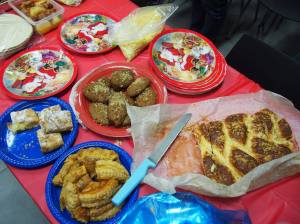
Melomakarona on the upper right and the chicken parmesan bread braid on the left. Photo Credit: Yoshitaka Sasaki
Along with local wines and brews, this lesson in understanding each other’s cultures turned into a wonderful little party. Taking a break from academia to celebrate a semester of hard work through our common love of food.

Brittany Wade is the editor of the Initiative for Heritage Conservancy blog and student of the MA in Heritage Management 2013. Having studied Classics in her undergraduate, Brittany is interested in applying her knowledge of history in the field of archaeology. Her interests are mainly in Prehistoric Minoan and Hellenic history.
Visiting the Oracle: Road Trip to Delphi
Living in Greece allows those interested in heritage sites unlimited amounts of opportunities to explore, especially if you have a friend with a car. Deciding to spend a beautiful sunny day on the road, several classmates and I made our own pilgrimage to the sacred site of Delphi. Traveling from Elefsina where the remains of the sanctified site of Eleusis still stands, we recreated a modern day procession to the place known in ancient times to be the center of the world. While driving through the mostly vacant, hilly terrain of Attica we suddenly saw jutting mountains with plunging valleys spring up around us as we entered the Greek state of Fokis. Arriving around the winding mountain roads towards the site, my jaw dropped. Those ancient Greeks sure knew how to pick their religious sites. The natural landscape alone gave the place a sense of holiness.
The moment the car was parked and we began our ascent to the site, the heritage management part of my brain kicked in. Our Greek friend who had driven us had asked if she would have to pay to get in. Knowing full well that you have to pay to get into a majority of the sites in Greece, this made me think that Greek citizens would be more likely to visit heritage sites in their own country if there were free or discounted admissions for them. Luckily, entrance is free for everyone the first Sunday of every month during the low season, which came as a pleasant surprise for us! But even when entrance is free, there are still some non-financial costs that remain, such as time and effort. Since we had not arrived until 2pm after our three hour journey, we were told that the site and the museum would be shutting down at 3pm. Although this is the advertised closing time, it startled me and my group since now we would have to rush our visit. And the site is huge. And uphill.
I tried to take in as much as I could, my eyes scanning every slab of marble and informational plaque at rapid speeds. We heard a whistle blow and a gentleman told us that the site would be closing and we needed to leave…it was only 2:15! This came as a disappointment, since the last admission advertised on the Greek Ministry of Culture and Sports website is at 2:30pm. Defiantly, we continued our upwards journey to at least see the amphitheater and its awe-inspiring view. It allows you to take in the whole of the site, which was bittersweet considering we were unable to see it in its entirety. On our way back down the Sacred Way, we saw a group of tourists all huddled around the omphalos (marble “navel” of the goddess Gaia). Not only were they leaning over the protective barricades, they were vigorously rubbing the stone while also attempting to push it off its plinth! While the management at Delphi is very professional in many aspects, it is not as “hands on” when it comes to close supervision. But this is understandable when it comes to a site so large.
Despite our haste, Delphi was a remarkable place to visit. It is a site so beautiful and so steeped in ancient history that it is a privilege to even quickly stop by. What I came away with after this visit was that the site might benefit from a S.W.O.T. analysis, assessing and addressing the potential Threats/Weaknesses to create more Opportunities for its visitors and to reinforce its existing Strengths. I will surely be back to complete my tour and encourage heritage enthusiasts and anyone else interested to embark on the incredible journey to sacred Delphi.
 Brittany Wade is the editor of the Initiative for Heritage Conservancy blog and student of the MA in Heritage Management 2013. Having studied Classics in her undergraduate, Brittany is interested in applying her knowledge of history in the field of archaeology. Her interests are mainly in Prehistoric Minoan and Hellenic history.
Brittany Wade is the editor of the Initiative for Heritage Conservancy blog and student of the MA in Heritage Management 2013. Having studied Classics in her undergraduate, Brittany is interested in applying her knowledge of history in the field of archaeology. Her interests are mainly in Prehistoric Minoan and Hellenic history.


